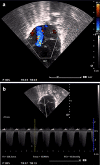Pulmonary hypertension in late onset neonatal sepsis using functional echocardiography: a prospective study
- PMID: 33991307
- PMCID: PMC9148354
- DOI: 10.1007/s40477-021-00590-y
Pulmonary hypertension in late onset neonatal sepsis using functional echocardiography: a prospective study
Abstract
Purpose: Pulmonary hypertension (PH) in the newborn period is associated with significant morbidity and mortality. Sepsis has been identified as an independent risk factor for PH in newborns. Data on the proportion and severity of PH in association with neonatal sepsis are scarce. This study was aimed to measure the pulmonary artery systolic pressure (PASP) in neonates with late onset sepsis (LOS) and to estimate the proportion of PH in neonatal sepsis using functional echocardiography (FnECHO).
Methods: This prospective observational study was conducted at a tertiary neonatal intensive care unit (NICU). All neonates admitted in the NICU with suspected LOS underwent FnECHO within 6 hours of onset of clinical signs and PASP was recorded. Pulmonary hypertension was defined as PASP of > 35 mmHg. PASP of neonates with positive culture results (proven LOS) was compared with that of gestational age-matched stable controls without sepsis.
Results: Thirty three neonates with proven LOS were analysed (study group). Sixteen neonates (49%) in the study group had PH. Mean PASP of the study group was significantly higher than that of the control group (35.3 ± 10.13 mmHg and 12.58 ± 3.92 mmHg, respectively; P < 0.0001). None of the neonates in the control group had PH.
Conclusion: Pulmonary artery pressure was higher in neonates with late onset neonatal sepsis as compared to that of stable babies without sepsis. Pulmonary hypertension was seen in nearly half of term as well as preterm neonates with late onset sepsis.
Keywords: Functional echocardiography; Neonatal sepsis; Pulmonary hypertension.
© 2021. Società Italiana di Ultrasonologia in Medicina e Biologia (SIUMB).
Conflict of interest statement
The authors declare that they have no conflict of interest.
Figures



Similar articles
-
Assessment of hemodynamic dysfunction in septic newborns by functional echocardiography: a systematic review.Pediatr Res. 2024 May;95(6):1422-1431. doi: 10.1038/s41390-024-03045-2. Epub 2024 Jan 20. Pediatr Res. 2024. PMID: 38245631
-
Association of vitamin D deficiency with an increased risk of late-onset neonatal sepsis.Paediatr Int Child Health. 2018 Aug;38(3):193-197. doi: 10.1080/20469047.2018.1477388. Epub 2018 Jul 13. Paediatr Int Child Health. 2018. PMID: 30003852
-
The effect of late-onset sepsis on mortality across different gestational ages in a neonatal intensive care unit: A historical study.Intensive Crit Care Nurs. 2023 Aug;77:103421. doi: 10.1016/j.iccn.2023.103421. Epub 2023 Mar 29. Intensive Crit Care Nurs. 2023. PMID: 37001447
-
Association between Congenital Anomalies and Late-Onset Bacterial Infections in Neonates Admitted to Neonatal Intensive Care Units in Australia and New Zealand: A Population-Based Cohort Study.Neonatology. 2025;122(1):95-105. doi: 10.1159/000540276. Epub 2024 Sep 19. Neonatology. 2025. PMID: 39299217 Free PMC article.
-
Effect of gestational age on the epidemiology of late-onset sepsis in neonatal intensive care units - a review.Expert Rev Anti Infect Ther. 2017 Oct;15(10):917-924. doi: 10.1080/14787210.2017.1379394. Epub 2017 Sep 25. Expert Rev Anti Infect Ther. 2017. PMID: 28901786 Review.
Cited by
-
Neonatal sepsis and cardiovascular dysfunction I: mechanisms and pathophysiology.Pediatr Res. 2024 Apr;95(5):1207-1216. doi: 10.1038/s41390-023-02926-2. Epub 2023 Dec 4. Pediatr Res. 2024. PMID: 38044334 Review.
-
Whole transcriptome profiling of cardiac injury: insights from a neonatal mouse sepsis model.Genes Genomics. 2025 May;47(5):599-613. doi: 10.1007/s13258-025-01632-z. Epub 2025 Mar 20. Genes Genomics. 2025. PMID: 40111648
-
Assessment of hemodynamic dysfunction in septic newborns by functional echocardiography: a systematic review.Pediatr Res. 2024 May;95(6):1422-1431. doi: 10.1038/s41390-024-03045-2. Epub 2024 Jan 20. Pediatr Res. 2024. PMID: 38245631
-
A pilot randomized controlled trial comparing noradrenaline and adrenaline as a first-line vasopressor for fluid-refractory septic shock in neonates.Front Pediatr. 2024 Oct 3;12:1443990. doi: 10.3389/fped.2024.1443990. eCollection 2024. Front Pediatr. 2024. PMID: 39421034 Free PMC article.
-
Neonatal Sepsis Caused by Streptococcus gallolyticus Complicated with Pulmonary Hypertension: A Case-Report and a Systematic Literature Review.Diagnostics (Basel). 2022 Dec 10;12(12):3116. doi: 10.3390/diagnostics12123116. Diagnostics (Basel). 2022. PMID: 36553123 Free PMC article.
References
-
- Nakwan N, Jain S, Kumar K, Hosono S, Hammoud M, Elsayed YY, et al. An Asian multicenter retrospective study on persistent pulmonary hypertension of the newborn: incidence, etiology, diagnosis, treatment and outcome. J Matern Fetal Neonatal Med. 2020;33(12):2032–2037. doi: 10.1080/14767058.2018.1536740. - DOI - PubMed
Publication types
MeSH terms
LinkOut - more resources
Full Text Sources
Other Literature Sources
Medical

